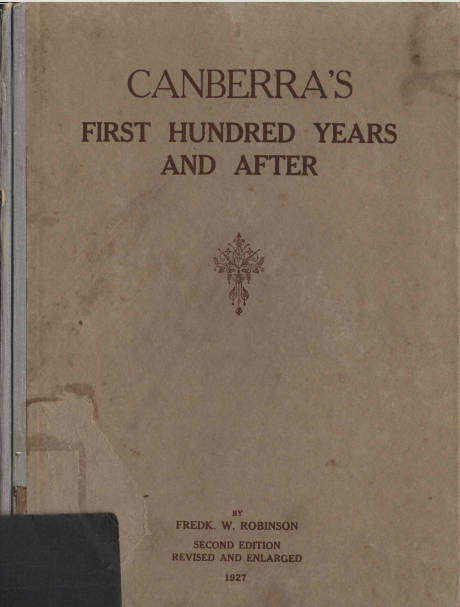Frederick W. Robinson, Canberra’s First One Hundred Years and After (1927)
Frederick Walter Robinson was a University Lecturer who became an early advocate of the development and political integration of Canberra as Australia’s capital city. Born in Sydney in 1888, he was something of an academic marvel in his early years, winning prizes and scholarships at the University of Sydney which led to him studying at the University of Jena in Germany, where in 1912 he received a PhD in Roman History for a thesis written in German. Returning to Australia, he served as Assistant Professor of Modern Languages at the Royal Military College, Duntroon. He enlisted in the Army in 1915, but being a devout Christian he joined the ambulance corps so as to uphold the principle ‘thou shalt not kill’.
Returning to Canberra once his service was up, Robinson fell in love with what at the time was still little more than a country town. In 1920 he led a protest over the disenfranchisement of ACT residents who were not given representation in the Federal Parliament. Under the logic of ‘no taxation without representation’, Robinson threatened to refuse to lodge a tax return, a stunt which earned him an investigation by the Commissioner of Taxation.
Canberra’s First One Hundred Years and After started out as a history of the local Anglican Church, but it quickly blossomed into a much broader work encompassing the entire span of European settlement in the region. This began in 1823 when Waterloo Veteran John Moore purchased 1742 acres of Crown Land at ‘Canberry’ – a name loosely ascribed to the Indigenous people of the region (now understood to mean meeting place).
After numerous chapters of sentimental history, the book concludes with a call to action:
‘The resolve to build a new city in the wilderness, as the symbol and centre of our young nationhood, was an inspiring thought which appealed strongly to many in the old world who did not know Australia, nor even own our race or speech. To ourselves, however, with that cheerful national irreverence to which Kipling recently paid tribute, the new city soon became a joke, a theme for incredulity, or even a mark of prejudice. But the time for these feelings, if it ever existed at all, is past. Canberra is now an established fact, and inspires enthusiastic admiration even in many who have gone thither prepared to scoff’.
This transformation of attitude was one which Menzies himself experienced. Initially scornful of the bush capital, by the time of his retirement he listed helping to facilitate the development of Canberra into a fully-fledged capital city as one of his greatest achievements. The Menzies Collection contains two copies of Canberra’s First One Hundred Years and After, a book which may have played some role in endearing the area to the longest ever resident of the Lodge.
The first copy is particularly intriguing, as it is inscribed as a memento of one of the most fateful events Menzies ever experienced in his time in Canberra, the Unity Conference of October 13-16 1944 which helped to beget the Liberal Party. Within the pages of this copy, there is also a pamphlet, ‘Concerning Canberra: The Christening and Dedication of Australia’s National Capital, 12th March, 1913, AND ITS DIRE NEGLECT’. Published in Melbourne in 1936, this was a call to arms demanding that political leaders stop neglecting the capital, a message that Menzies surely heeded.
Sign up to our newsletter
Sign up for our monthly newsletter to hear the latest news and receive information about upcoming events.


